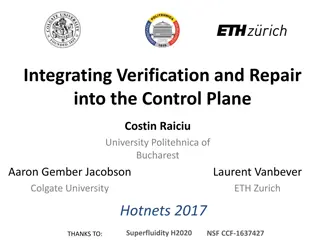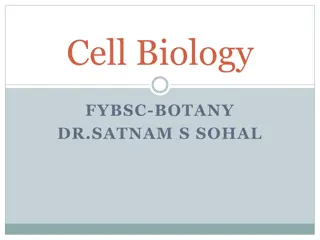Establishing Plant Cell Division Plane: Key Mechanisms Unveiled
Plants exhibit a unique cell division process essential for growth and development. This process involves intricate control over the positioning of a new cell wall, crucial for proper patterning. Symmetrical and asymmetrical divisions play distinct roles in plant body formation, each regulated by specific factors. Preprophase Band (PPB) formation and function, along with actin-microtubule interactions, are pivotal in establishing the division plane. The TON1/TRM/PP2A complex, including proteins like formins and Myosin VIII, plays a crucial role in proper PPB assembly. Understanding these mechanisms sheds light on the precise regulation of plant cell division orientation.
- Plant Cell Division
- Division Plane Establishment
- Symmetrical Divisions
- Asymmetrical Cell Divisions
- PPB Formation
Download Presentation

Please find below an Image/Link to download the presentation.
The content on the website is provided AS IS for your information and personal use only. It may not be sold, licensed, or shared on other websites without obtaining consent from the author. Download presentation by click this link. If you encounter any issues during the download, it is possible that the publisher has removed the file from their server.
E N D
Presentation Transcript
CELL DIVISION PLANES Plants, a significant source of planet wide biomass, have an unique type of cell division in which a new cell wall is constructed de novo inside the cell and guided towards the cell edge to complete division. The elegant control over positioning this new cell wall is essential for proper patterning and development. Plant cells, lacking migration, tightly coordinate division orientation and directed expansion to generate organized shapes. Several emerging lines of evidence suggest that the proteins required for division plane establishment are distinct from those required for division plane maintenance. Cell division, a fundamental requirement for life, is carefully regulated in both space and time. Symmetrical proliferative divisions are essential for growth and account for the vast majority of plant cell divisions. When and where proliferative divisions occur along with expansion and differentiation allows formation of the entire plant body. Formative (asymmetrical) divisions are critical for the development of new cell-types. Due to their precise role in development, asymmetrical cell divisions tend to be initiated by specific transcription factors and signaling pathways More elongated cells tend to divide along the shortest plane, whereas less elongated cells have more division-plane variability
Establishing the division plane Before the cell divides, several requirements must be met. The cell reaches a minimal size and the nucleus migrates toward the center of the cell during symmetrical divisions or to another location in asymmetrical divisions. Interactions between cell-cycle regulators and proteins required for division-plane establishment have been identified. Focus on PREPROPHASE BAND (PPB) form and function: Not all plant cells require a PPB for division-plane orientation. Examples of PPB-independent divisions include meiocytes, endosperm and some moss cells. Many PPB-independent divisions occur in invariant locations suggesting strong positioning cues. Discovering yet unknown positioning mechanisms may identify highly conserved features of plant cell division orientation. The PPB is a microtubule and actin filament structure that assembles in G2 and aligns with the future division site. PPB orientation often matches that of interphase microtubules. Multiple microtubule-associated proteins co-localize with the PPB. This PPB subtends the cortical division zone (CDZ), a local region of the membrane. The CDZ is characterized by increased accumulation of clathrin-coated endocytotic vesicles. As the PPB forms, increased interactions occur between actin filaments and microtubules. Indeed, actin filament disruption by drugs or mutants induces both PPB widening and defects in division-plane orientation
PPB actin-microtubule interactions are possibly mediated by actin and microtubule-binding proteins that localize to the PPB, such as formins, Myosin VIII, or kinesins. The potential role of microtubule-actin crosslinking proteins in refining division-plane orientation or PPB narrowing is still unknown. Proper PPB assembly and division-plane establishment requires a complex of conserved type 2A protein phosphatase subunits (PP2A), plant-specific proteins, and those similar to centrosomal proteins, called the TON1/TRM/PP2A (TTP) complex. Key components of the TTP complex are identified by mutants with short, thick barrel stature called tonneau (ton). These mutants have cell elongation defects due to aberrant interphase microtubule array organization. In addition, cells do not form PPBs and have division plane defects. fass is allelic to ton2, encoding a B00 regulatory subunit of the PP2A. Similar to fass, maize fass homologs discordia1 and alternative discordia1 together are required for PPB formation and their proteins localize to the division site until metaphase, potentially to promote specific protein dephosphorylation. Other TTP components have conserved domains common to centrosomal proteins encoded by two highly similar genes tonneau1a (ton1a) and ton1b which together are required for PPB formation and interphase microtubule array organization. TON1 colocalizes with interphase microtubules and PPBs.
Recently, an interaction between TON1 and many of a 34-member protein family containing a conserved motif named the TON1- recruiting motif (TRM) was identified. Several, but not all, TRM proteins bind microtubules and different TRM proteins interact with TTP proteins. Specificity may be controlled by TRMs with different binding affinity for TTP members or microtubules. It is still unclear what proteins are de-phosphorylated and how that leads to proper interphase microtubule array organization and PPB formation. One difficult question is whether interphase microtubule array organization can be functionally separated from PPB formation. Important insight has come from recent analysis of partial-loss-of-function mutants with more severe defects in PPB formation than apparent interphase microtubule array organization. These mutants display almost normal growth and mild division-plane orientation. The ton1a single mutant lacks proper PPBs, yet many divisions were still properly oriented, especially in root cortex cells. The triple trm 6,7,8 mutant lacks proper PPBs but grows well. These three TRMs compose a small subfamily and encode about a quarter of TRMs with a probable microtubule-binding motif. Although the PPB does not form normally, Phragmoplast orienting kinesin1 (POK1) still localizes at the division site, although less often than in wild-type (WT) cells. The trm mutants lacking proper PPBs had aberrant spindle rotation and division-plane defects.
Division-plane establishment and maintenance. (a) Examples of typical land-plant preprophase band (PPB) of wild-type Arabidopsis (top left) and mitotic microtubule structures in maize (from prophase with a PPB until the new cell wall is formed, top right). (b) Mutants with defects in division-plane establishment lacking a clear PPB (tonneau1 recruitment motif, (trm6,7,8), bottom left) and maintenance, assessed by time-lapse imaging, when the new cell wall does not return to the location of the PPB (tangled1 (tan1) mutant, bottom right).Merged images (far right) show late prophase cell (with PPB in green and indicated with white brackets) and finished cell division (in magenta, asterisk shows misplaced new cell wall). Left panels were modified from (Schaefer et al., 2017) and reprinted with permission from the authors and AAAS. Right panels were modified from (Martinez et al., 2017b) with permission from the authors. Bars, 10 lm
The PPB is thought to promote spindle bipolarity and prevent spindle rotation. When the PPB forms, microtubules accumulate around the nucleus perpendicular to the PPB before metaphase. If the PPB does not form, microtubules accumulate non-specifically around the nucleus, which delays spindle formation. Interestingly, in early gametophytic moss cells that do not make PPBs, spindle bipolarity is still anticipated by bipolar accumulation of cytoplasmic microtubule organizing centers to promote proper division-plane orientation, similar to cytoplasmic microtubule organizing centers that accumulate before PPB formation in Marchantia polymorpha. Although altered spindle positioning may lead to divisionplane defects, spindle rotation and other defects occur in many cells without division-plane defects.
Accumulation of division site localized proteins required for establishment and maintenance of symmetrical plant cell divisions. This schematic representation of the cell cycle indicates key transitions, not the timing of the transitions. The position of cortical microtubule arrays (black) and DNA (gray) of plant cells is shown together with phases of the cell cycle. The localization of proteins that promote proper formation of the preprophase band (PPB) are listed under Establishment. TON1a (red) localizes to the interphase microtubule array, then the division site during prophase and part of metaphase. FASS/TON2/DCD1/ADD1 and TRM7 (orange) localize to the division site from prophase to metaphase. TRM1 and TRM8 (green) localize to the interphase cortical array and the PPB, similar to many microtubule-binding proteins. TAN1, POK1, POK2, KCBP, RAN-GAP and MAP65-4 (blue) localize to the division site from prophase through cytokinesis. PHGAP1 and PHGAP2 (indigo) localize to the division site from metaphase through cytokinesis. AIR9 (violet) localizes to the division site along the violet track, co-localizing with the interphase microtubule array, then co-localizing with the PPB. AIR9 localizes to the division site when the phragmoplast reaches the cortex.
A schematic of currently known division-plane establishment and maintenance interactions. Potentially indirect protein protein interactions identified by mass-spectrometry are indicated with dotted magenta lines, direct protein protein interactions are indicated with black lines, whereas genetic interactions are indicated with green lines. Establishment: the components of the TON1/TRM/PP2A (TTP) complex. TON1a interacts with. FASS/ TON2 interacts with TON1a, TON1b and PP2A. TRM1 interacts with TON1a via a region of TRM1 containing conserved domain 2. TON1a interacts with multiple TRMs (2, 3, 7, 11, 14, 19, 20, 21, 22, 25 and 26). TRM19 interacts with TON1, FASS/TON2 and PP2A. TRM1, TRM3 and TRM29 interact with FASS/TON2, probably via interaction with conserved TRM domain 3. CDKA interacts with TON1a and TON1b : genetic interactions suggest that speeding up cell-cycle progression worsens division-plane defects of ton1a mutants. Maintenance: POK1 interacts with TAN1, RAN-GAP and PHGAP1 and 2. tan1 air9 double mutants have a synthetic division-plane orientation defect suggesting genetic interaction. AIR9 physically interacts with KCBP. CDKA, KCBP and RANGAP1 are labeled in gray to reflect that specific roles in division-plane establishment or maintenance are still unclear. This model reflects our current understanding of division-plane establishment and maintenance but there are likely as-yet-unidentified proteins and interactions between them























